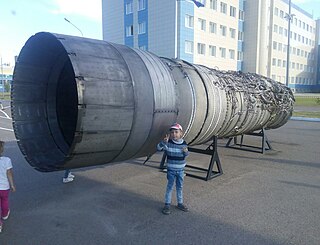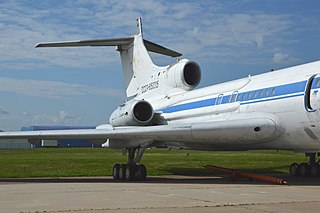Related Research Articles

The Tupolev Tu-154 is a three-engined, medium-range, narrow-body airliner designed in the mid-1960s and manufactured by Tupolev. A workhorse of Soviet and (subsequently) Russian airlines for several decades, it carried half of all passengers flown by Aeroflot and its subsidiaries, remaining the standard domestic-route airliner of Russia and former Soviet states until the mid-2000s. It was exported to 17 non-Russian airlines and used as a head-of-state transport by the air forces of several countries.

The Tupolev Tu-155 is a modified Tupolev Tu-154 (СССР-85035) which was used as an alternative fuel testbed, and was the world's first experimental aircraft operating on hydrogen and later liquid natural gas. The similar Tu-156 was never built.
The Kuznetsov Design Bureau was a Russian design bureau for aircraft engines, administrated in Soviet times by Nikolai Dmitriyevich Kuznetsov. It was also known as (G)NPO Trud and Kuybyshev Engine Design Bureau (KKBM).

The Tupolev Tu-95LAL was an experimental aircraft that was a modified Tupolev Tu-95 Soviet bomber aircraft, which flew from 1961 to 1965, analogous to the United States' earlier Convair NB-36H. It was intended to see whether a nuclear reactor could be used to power an aircraft, primarily testing airborne operation of a reactor and shielding for components and crew. The reactor did not actually power the aircraft.

The Tupolev Tu-244 was a proposed supersonic transport (SST) aircraft, developed from the Tu-144. It implemented novel features such as cryogenic fuel to enable flight distances of up to 10,000 km (6,200 mi) and would have carried up to 300 passengers. The project was cancelled in 1993.

The Tupolev Tu-330 was a proposed Russian medium-size transport aircraft developed by Tupolev since the early 1990s. The project was stopped around 2000s due to lack of funding and difficult economic situation of the Russian aircraft industry at the time.

The NK-8 was a low-bypass turbofan engine built by the Kuznetsov Design Bureau, in the 90 kN (20,000 lbf) thrust class. It powered production models of the Ilyushin Il-62 and the Tupolev Tu-154A and B models.

The Kuznetsov NK-144 is an afterburning turbofan engine made by the Soviet Kuznetsov Design Bureau. Used on the early models of the Tupolev Tu-144 supersonic aircraft, it was very inefficient and was replaced with the Kolesov RD-36-51 turbojet engine.
JSC Kuznetsov is one of the leading Russian producers of aircraft engines, liquid-propellant rocket engines as well as aeroderivative gas turbines and modular stations.
The Kuznetsov NK-14A was an onboard nuclear-powered engine which was made to be used on the Tupolev Tu-119 nuclear-powered aircraft, designed and built by the Soviet Kuznetsov Design Bureau. The design of the plane was based on a modified Tupolev Tu-95 and would be fitted with two Kuznetsov NK-14A nuclear-fuelled engines inboard fed with heat from a fuselage mounted reactor and two Kerosene-fed Kuznetsov NK-12 turboprops outboard.
The Kuznetsov NK-87 is a low-bypass turbofan engine rated at 127.5 kN thrust. It powers the Lun-class ekranoplan. It is made by the soviet Kuznetsov Design Bureau.

Nikolai Dmitriyevich Kuznetsov was a Chief Designer of the Soviet Design Bureau OKB-276 which deals with the development, manufacture and distribution of equipment, especially aircraft engines, turbines and gearboxes.

The Kuznetsov NK-25 is a turbofan aircraft engine used in the Tupolev Tu-22M strategic bomber. It can equal the NK-321 engine as one of the most powerful supersonic engines in service today. It is rated at 245 kN (55,000 lbf) thrust. The three shaft engine we call the NK-25 was designed in the years 1972–1974. It is made by the Soviet Kuznetsov Design Bureau.

The Kuznetsov NK-93 was a civilian aircraft engine, a hybrid between a turbofan and a turboprop known as a propfan. The engine was also unique in having a separate duct around the contra-rotating propellers, as most other propfans are unducted. Once described in a respected aviation encyclopedia as "potentially the most fuel-efficient aircraft jet engine ever to be tested", the NK-93 was targeted for derivatives of Soviet/Russian airliners such as the Ilyushin Il-96, Tupolev Tu-204, and Tupolev Tu-330. Five in-flight engine tests were conducted on the NK-93 from December 2006 to December 2008.
The Kuznetsov NK-4 is a turboprop engine, designed by the Kuznetsov Design Bureau.
The Kuznetsov NK-22 is an afterburning turbofan engine, designed by the Kuznetsov Design Bureau.

The Kuznetsov NK-88 was an experimental alternative fuel turbofan engine, designed by the Kuznetsov Design Bureau.
The Kuznetsov NK-6 was a low-bypass afterburning turbofan engine, designed by the Kuznetsov Design Bureau.

The Kuznetsov TV-022 was the first Soviet turboprop engine, designed by the Kuybyshev Engine Design Bureau.
The Kuznetsov TV-2 was a turboprop engine, designed by the Kuybyshev Engine Design Bureau.
References
| | This aircraft engine article is missing some (or all) of its specifications. If you have a source, you can help Wikipedia by adding them. |